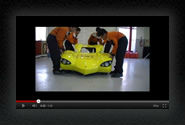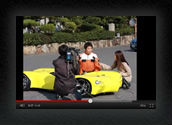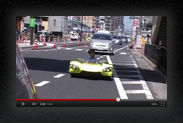The students and teachers of The Automobile Engineering Course of Okayama Sanyo High School, have produced "Lowest Roadworthy Car". Eleven students ( 4 senior, 7 freshmen) produced this car, and nine teachers helped them.
The students named this car "MIRAI", that means "future" in Japanese.
The total height from the floor to the top of the car is 452.0mm, which is less than 18 inches (457.2mm).
The car is roadworthy, and is registered legally to Asakuchi-city, Okayama-Pref., Japan.
It is delivered with a number plate " Asakuchi-City 60".
The car is electric-driven. It has two electric motors with 540w of output (total) inside the both of the rear wheels.
The driving unit (motors and the controlling components including batteries) are from "Q-car", produced by CQ Motors, Japan. The switching console is from motorbike.
The chassis(steel), body(FRP), suspension, steering systems, lights(LED), seat, and all the other parts and equipments are originally made by the students and teachers.

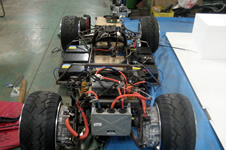

This project started in August, 2009. It took several months to complete the planning and designing.
The production of the car started at May, 2010.
At first, the car was designed with gasoline engine, with 49cc of engine displacement.
When the total height from the ground to the top of the car is be less than 18 inches (457.2mm), with the road clearance of at least 90mm (legal standard in Japan), the thickness of the car has to be less than 367.2mm.
So, we cut off the upper and lower side of the steering wheel, and change the steering system from rotating style to "push and pull" style. Also, as to the suspension system, we adopt "push rod" style, with the coil spring laid down, that most formula racing cars adopt. We had many more devices other than these to compress the thickness.
By around mid of the August, 2010, the car was almost completed.
But at this point, we came to think of the atmosphere, as to the automobile production in our country. In today's Japan, switching to the ecological society is emergency task. And, we decided to change it into an electric vehicle.
Then, we unloaded the gasoline engine and other accompanying parts, and re-designed the car into electric vehicle with motors and batteries.
The biggest problem was the weight of the batteries. The car has six main batteries and one assistant battery, and the total weight of them is about 90kg.
So, we had to reinforce the entire chassis to hold this big weight.
The cutting and welding of the chassis are made by the students. Also, the arrangement of the electrical equipments and wire harnessing are made by the students.
As to the production of the FRP body, we teachers took charge in the most part of it, because, at the process of plastic molding, we had to use some poisonous materials with volatility.
The date of completion is Nov.15, 2010, that we decided the date as a goal in advance. Last one week was almost a hell. Some students volunteered to stay until very late to take part in the production. Also, some of the teachers stayed overnight in the garage of the automobile engineering course in our school.
At 13:00, November 15th, 2010, we had a ceremony for new-car-release exhibition for this car. On that day, the so many crews from most of Japanese TV stations and national newspapers covered this event.
The accurate time of the completion of this car was 12:55, Nov. 15th, 2010, only five minutes before the scheduled opening time of the ceremony.
The ceremony was opened with the fanfare performed by our school band. The leader of the students announced that they had named this car "MIRAI", means "future" in Japanese. Some TV crews tried driving on this car, and one of them almost crashed to the wall.
After this, we started the procedure of application for the Guinness World Records.
All the procedures were finished on March 11th, 2011, and finally, we received the certificate that proves our challenge was proved as the world record on June 3rd, 2011.
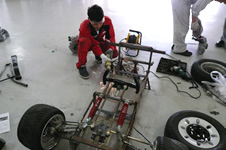
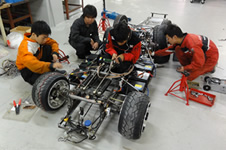
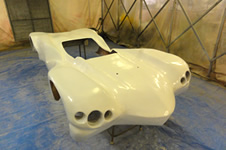
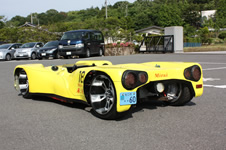
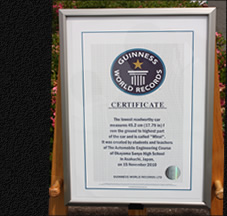
| 2009 Autumn | Project Start |
|---|---|
| 2010 April | Start of production, as a car with a gasoline engine |
| 2010 August | Changing plan to Electric Vehicle |
| 2010 Nov. 15th | Completion of the car |
| 2011 Mar. 11th | Completion of the world record application |
| 2011 Jun. 3rd | Receiving the certificate from Guinness World Records |
| Name of the car | MIRAI |
|---|---|
| Body number | K00655 |
| Rated output | 0.29×2kW(580W) |
| Classification | 4 wheel mini - car |
| Fuel | Electricity |
| Max speed Fw/Rw (km/h) | 50/15 |
| L×W×H (mm) | 2,480×1,254×452 |
| Wheel base (mm) | 1,660 |
| Tread (mm) | Front 962 / Rear 822 |
| Minimum ground clearance (mm) | Front 94 / Rear 98 |
| Weight (kg) | 280 |
| Riding capacity | 1 |
| Mileage per a charge | 80km(at 30km/h), 60km(10 mode) |
| Main battery | Sealed lead battery 12V×42Ah×6 (72V) |
| Assistance battery | Sealed lead battery 12V×28Ah×1 (12V) |
| Charge system | 3 steps, Constant current, constant potential charge |
| Break system | 4 wheel drum break (Front / Rear : Mechanical) |
| Engine / Drive system | Permanent magnet type synchronization electric motor / Rear wheel direct drive |
| Suspension system | Front : Strut type Rear : Trailing arm type |
| Average Charge time (h) | 8 |
The Automobile Engineering Course
Okayama Sanyo High School
2069, Rokujoin-naka, Kamogata, Asakuchi, Okayama-Pref. 719-0252, Japan.
E-mail Address :
Telephone Number : +81-865-44-3100.











